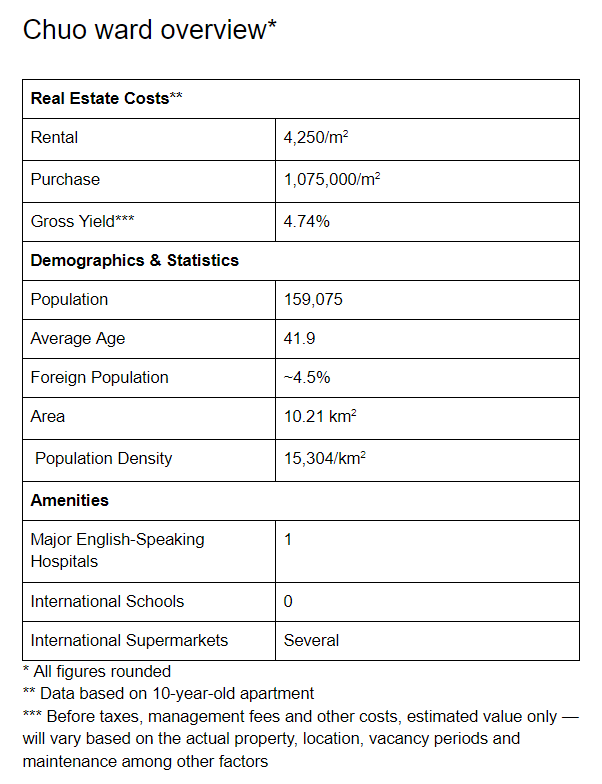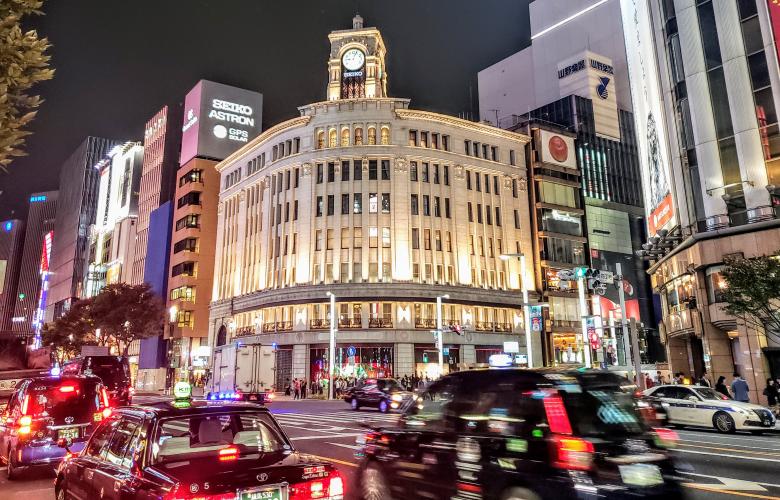Chuo City, as it is officially known in English, is one of Tokyo’s C5W (central 5 wards). Located on the waterfront of Tokyo Bay, it borders thw wards of Minato and Chiyoda to the west and Sumida and Koto to the east. The small ward is only 10.21 km2, but packs some of Tokyo’s most well-known areas.
One of those areas is Nihonbashi, where the Bank of Japan and the Tokyo Stock Exchange are located. Many financial corporations have their headquarters here. Close by are the Yaesu and Kyobashi business districts, which are located next to Tokyo Station. A number of redevelopments of office buildings have modernized the area and its appeal in recent years.
Ginza, home to luxury department stores and high-end designer boutiques, is one of Tokyo’s most desirable shopping areas and is especially popular with travellers from Asia. Close by is the old Tsukiji Fish Market, once the largest in the world. The market is now in Toyosu and the prime real estate in central Tokyo freed up by the move is a hot topic of speculation for investors. At the moment, it is slated to be turned into a transportation hub during the 2020 Olympics, with plans for redevelopment after the game still remain unclear.
The waterfront areas of Chuo, Kachidoki and Harumi, are developing into upscale residential areas with many new tower condos under construction. The area has become especially popular with upper middle class young families.
Lifestyle
Chuo offers its residents an urban lifestyle with all the modern conveniences one could ask for. The ward is centrally located with easy and often direct access via train to all of Tokyo’s major stations. High-end tower condos are springing up, especially in the waterfront areas.
Chuo ward is known for its dining options: ranging from Michelin-star sushi around Tsukiji, to international cuisine. Across the Sumida River, Tsukishima is famous for casual local food such as monjayaki. The Ginza area is one of Japan's most popular shopping districts.
Chuo City’s closeness to the bay offers great views from many of the residential properties here. The waterfront also is a nice backdrop for a stroll. The ward is quite densely built up, but some spots of serene greenery exist, most beautiful of all is Hamarikyu Gardens, an old imperial garden with a long history and a beautiful tea house open to the public located on its central pond.
Demographics
159,075 residents call Chuo ward their home. With a population density of 15,304 km2, and a total of 7,187 foreign residents, it is one of the less diverse districts of Tokyo with a fairly small international community of less than 5%. The average age in Chuo is 41.9, making it the youngest of all of Tokyo’s wards; possibly thanks to the recent influx of young families with children.
Amenities and attributes
Chuo has everything a resident or visitor would need. Ginza’s shopping opportunities are ever-expanding; recently, the long-established high-end boutiques the area is famous for have gotten new neighbours in the form of malls with mid-range brands that target younger shoppers. The area is also famous for some of Tokyo’s best dining options. For grocery choices, food import store chains Seijo Ishii and Kaldi Coffee Farm have several outlets in Chuo Ward.
St. Luke’s International Hospital is located in Chuo ward and favoured by the local expat community. It operates on international standards, always has English-speaking physicians on duty, and boasts very good reviews.
There is no shortage of gyms in the ward. The 24-hour chain Anytime Fitness operates several branches and Gold’s Gym has a Ginza branch. Many popular Japanese gyms also have outlets here, with Tokyu Sports Oasis St. Luke’s Tower Store being a popular choice.
There are no international schools located in Chuo, but several in neighbouring Minato and nearby Shibuya. However, a small number of international pre-schools are located here.
Major stations in Chuo City include Nihonbashi, Ginza, Tsukiji, Kachidoki, Tsukishima, and Hatchobori. From Ginza, it takes 2 minutes to Tokyo Station and 15 minutes to Shibuya Station. It takes approximately 70 minutes to Narita Airport from Ginza, and around 45 minutes to Haneda Airport.
Real estate details
As one of the C5W, Chuo real estate, especially in the Ginza area, is some of the most expensive in Tokyo to buy or rent. However, a lot of the properties are built on reclaimed land, which is associated with a higher risk during tsunamis, making Chuo is the cheapest of the C5W and also more affordable than other centrally located wards, e.g. Meguro or Shinagawa wards. A new property will cost you on average JPY 1,180,000/m2, with the price falling to JPY 900,000/m2 for 20-year-old units and 790,000/m2 for 30-year-old units.
Rental prices are also lower than in the other C5W, but higher than in other wards located within the Yamanote Line, creating a mild rent distortion that can be favourable for investors( i.e. sales prices are slightly lower while rent is slightly higher than comparable areas). A new rental up to five years oldfetches JPY 4500/m2 on average. Older places of 20 and 30 years still return approximately JPY 3870/m2 and JPY 3670/m2 respectively.

By Mareike Dornhege
Similar to this:
Minato ward guide: Tokyo’s international centre
Shinjuku ward guide: Tokyo’s beating neon heart
Shibuya area guide: Life in Tokyo's most famous quarter






